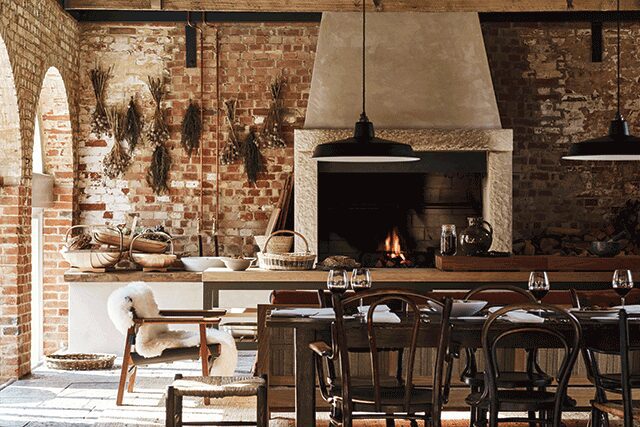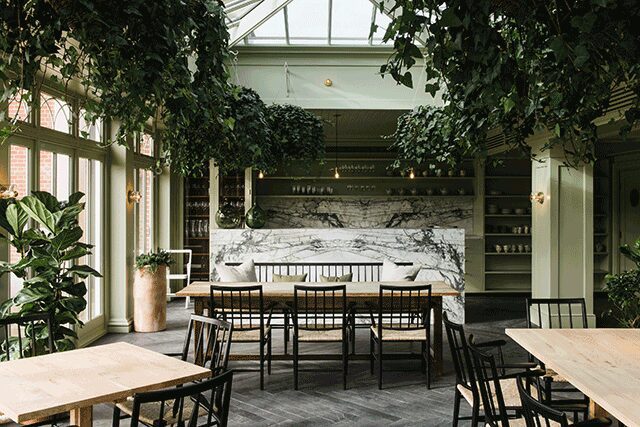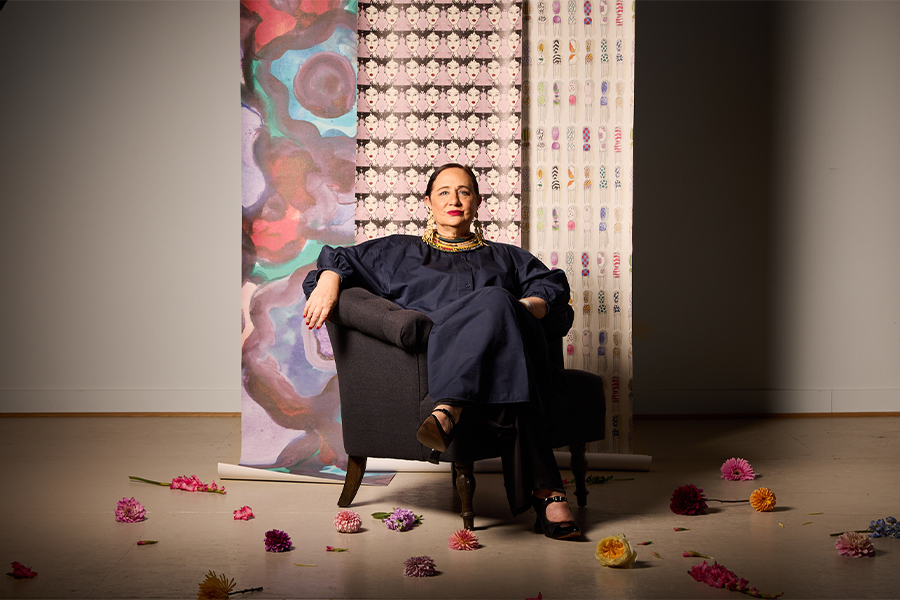With fall 2018’s much-awaited launch of country-house hotel Heckfield Place, set in a 17th-century Georgian mansion that took seven years to renovate, the Hampshire property’s culinary director Skye Gyngell can finally get her hands dirty—in organic soil, to be precise. Part of the reason the former Australian Vogue food editor-turned-Michelin-starred chef took on the job at Heckfield was the onsite biodynamic farm she was instrumental in designing.
Gyngell, who earned her Michelin star at Petersham Nurseries Café in London, believes in the advantages of biodynamic farms, which use holistic, ecological and ethical approaches to farming. Her passion bears witness at Spring, Gyngell’s produce-driven eatery in London that sources ingredients from a biodynamic farm in Herefordshire. (Gyngell cooks weekdays at Spring and weekends at Heckfield Place.) All produce for Gyngell’s heartily portioned dishes at Heckfield’s two restaurants comes straight from the hotel’s farm, which abuts a 400-year-old arboretum and an ornamental lake within the private grounds.
Gyngell worked alongside American owner Gerald Chan, head of a private equity group in Boston, and UK-based designer Ben Thompson to create the restaurants’ interiors, a soothing mélange of monochrome tones accented with rich textures that embody an elevated country kitchen feel—think creamy furnishings, pea green walls, and veined white marble surfaces dripping with succulents at Marle and an oversized, soot-covered cooking fireplace at Hearth.
Here, Gyngell shares her thoughts on the project and the evolution of British cuisine.

The raised fireplace in Hearth where Gyngell cooks
How did you come up with the menu?
It’s quite easy to come up with a menu when you work with a farm. I know there are millions of black tomatoes, I know all the romanescos needs to come out of the ground, I know we’ve got some tomatillos—so you start with the produce and then you build the menu around it. And it’s easier in many ways because it hands you what there is to cook, which I find simpler than where you can pick anything from anywhere. And we cook simply. Our aim was to showcase the ingredients rather than to hide them or change them in any big way. So it’s just, ‘This is beautiful, it’s perfect, how do I give it to you and do the least to it so you can experience the food?’
Did you take inspiration from the building’s history for the menu?
We wanted to do very classic, unpretentious food but try to make it as contemporary as possible. You know English food has classically been kind of stodgy. It hasn’t been famous for its cuisine. Or it has, but in a negative way. Take some of those classics like jam. We have such a beautiful history of soft fruit in this country—raspberries, strawberries, black currants, crab apples, quinces, pears—they’re almost ancient. They were the life blood of this country, especially orchards. So to look back at what people did and do it in a little bit of a lighter way. We make everything here: all the butter, all the yogurt, all the digestives and liqueurs on the bar are made from the farm.

Greenery mixes with white marble surfaces at Marle
Why did you choose to make the farm biodynamic?
I believe so passionately in small farms. I believe in the importance of good clean soil and even more [in] biodynamic practice. I think about [biodynamic principles] in a simple way: Our whole lives are governed by the sun and the moon. We rise with the sun, we sleep [with the sun]. If you strip back hundreds of years, that’s how people lived. What drew me here originally was the land. The thing that interested me right from the beginning was the potential of the farm. You can’t separate the purpose of this hotel from its landscape. The work we can do here is important because this will probably be the largest biodynamic farm in England. We’re in the conversion [phase]. Although we’re practicing biodynamically on the farm the conversion takes a couple of years. To return the soil, especially in the vegetable gardens, to energized, fertile, and healthy soil will take a long time because it’s had chemicals on it.

English country living served as a muse in Hearth
How involved were you in terms of décor?
We worked as a team completely. Ben [Thompson] is a lovely person to work with. Gerald [Chan] very much wanted to create something very different. Most things you see here are built by English craftsmen. For all the lights by your bed, there’s a ceramicist who made all the bases. All the plates were commissioned. There are all old Welch chairs [in Hearth] that were sourced to match an old Welch table. It’s been a real mixture of buying old things and also using British craftsmen to make everything. There are river rush mats in the rooms made from reeds from the local river, and they’re the sweetest smelling reeds that you can get in England. You water it to keep it alive and textured.
And for me, of course, to have to say and to set the story to then deliver the vision [was very important]. What do we want people to feel like here? What do we want to use the Morning Room for? How do we want to serve afternoon tea? For example, Hearth originally started as a pub and the [raised] fireplace was on the ground. I was like, ‘No, let’s cook over fire,’ and Ben said, ‘Okay, let’s put a sofa in front.’ He created it completely but with everybody working together for a vision.


